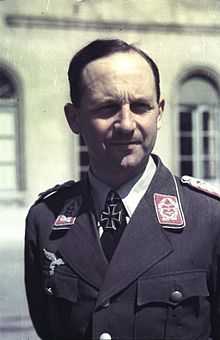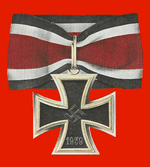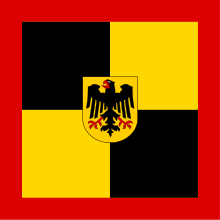Heinrich Trettner
| Heinrich Trettner | |
|---|---|
 | |
| Born |
19 September 1907 Minden |
| Died |
18 September 2006 (aged 98) Mönchengladbach |
| Allegiance |
|
| Service/branch |
Heer Condor Legion Luftwaffe |
| Years of service |
1925–45 1956–66 |
| Rank | General |
| Unit | 7. Flieger-Division |
| Commands held | 4. Fallschirmjäger-Division |
| Battles/wars |
Spanish Civil War |
| Awards |
Knight's Cross of the Iron Cross with Oak Leaves Great Cross of Merit with Star and shoulder ribbon |
| Other work | Bundeswehr |
Heinrich "Heinz" Trettner (19 September 1907 – 18 September 2006) was a German general serving during World War II and from 1964 to 1966 Inspector General of the Bundeswehr. He was also a recipient of the Knight's Cross of the Iron Cross with Oak Leaves. The Knight's Cross of the Iron Cross and its higher grade Oak Leaves was awarded to recognise extreme battlefield bravery or successful military leadership. He was the last living general of the Wehrmacht.
Spanish Civil War
After completing the third course at the Luftkriegsschule 2 (Air Warfare School) in Berlin, Trettner joined the Condor Legion and served as adjutant and IIa to Generalmajor Hugo Sperrle and Wolfram Freiherr von Richthofen during the Spanish Civil War. On 2 October 1937 he was made Staffelkapitän of 1./K 88.[1]
Second World War
At the start of the war Trettner was serving as Staff Officer, Operations (Ia) in the Staff of the 7th Fliegerdivision until 14 June 1939. At the same time Trettner was assigned as an advisor with the Fallschirmjäger Inspectorate from 1 January 1939 to 14 December 1940. During the Polish and French campaigns he served as the Chief Of Operations in the Staff of the 7th Fliegerdivision until 14 December 1940. He was later appointed Chief Of Operations in the Staff of the XI. Fliegercorps (15 December 1940 to 6 April 1942), taking part in the airborne operation on Crete. For this he was promoted to Chief of Staff of the XI. Fliegercorps, but on 4 October 1943 was reassigned to head formation and become Commanding Officer of the 4th Fallschirmjäger-Division, a command he held until 3 May 1945 when he was taken prisoner by US troops. He was later transferred to the British Army POW camp in UK, and remained incarcerated until 12 April 1948.
Post World War II
Heinrich Trettner was released as a prisoner of war in April 1948 and worked initially for the Diözesan-Caritasverband. He completed his merchant apprenticeship with "Vaupel Sohn", a glass retailer Düsseldorf, in May 1949. He then enrolled at the University of Bonn and studied Economics and Jurisprudence, and received his diploma in Economics in 1956.
Immediately after he received his diploma Heinrich Trettner then joined the Bundeswehr. He was then transferred to the Supreme Headquarters Allied Powers Europe SHAPE in Paris serving as commander of the logistics department until 15 September 1959.
As Inspector General, Trettner apparently had a poor relationship with Karl Gumbel, the civilian Deputy Minister of Defence, and objected to taking orders from a civil servant, Gumbel, in the absence of the Minister. He was also opposed to a ruling by the Minister, in the face of a court order, that members of the military could join a union. These factors led to his resignation, which nearly coincided with that of Werner Panitzki, the chief of staff of the Luftwaffe.[2]
General Trettner was one of the umpires for the 1974 Sandhurst wargame on Operation Sea Lion.
Heinrich Trettner died one day before his 99th birthday. He was the last living general of the Wehrmacht.
Awards
- Cruz de Guerra de España (30 September 1938)[3]
- Medalla de la Campaña de España (1 December 1938)[3]
- Cuffband Crete
- Spanish Cross in Gold (6 June 1939)[3]
- Wound Badge (1939) in Black (3 March 1944)[4]
- Iron Cross (1939)
- Combined Pilots-Observation Badge in Gold with Diamonds
- Knight's Cross of the Iron Cross with Oak Leaves
- Knight's Cross on 24 May 1940 as Major in the general staff and Ia (operations officer) of the 7. Flieger-Division[5]
- 586th Oak Leaves on 17 September 1944 as Generalmajor and commander of the 4. Fallschirmjäger-Division[6]
- Mentioned in the Wehrmachtbericht on 28 June 1944
- Legion of Merit (USA) (1 November 1964)[4]
- Knight Commander of the Royal Victorian Order (Great Britain) (18 May 1965)[4]
- Grand Cross of the Order of George I (Greece) (16 July 1965)[4]
- Grand Officer of the Order of Merit of the Italian Republic (Grande Ufficiale Ordine al Merito della Repubblica Italiana) (Italy) (8 August 1965)[4]
- Grand Cross with Star and Sash of the Order of Merit of the Federal Republic of Germany (18 January 1967)[4]
- Grand Officier of the Légion d'honneur (France) (31 December 1969)[4]
Wehrmachtbericht reference
| Date | Original German Wehrmachtbericht wording | Direct English translation |
|---|---|---|
| 28 June 1944 | In den schweren Abwehrkämpfen des Trasimenischen Sees haben die 29. Panzergrenadier-Division unter Führung von Generalleutnant Fries, die 4. Fallschirmjägerdivision unter Führung von Oberst Trettner und die 356. Infanteriedivision unter Führung von Generalleutnant Faulenbach, hervorragend durch Artillerie und Flakartillerie unterstützt, alle mit überlegenen Kräften geführten Durchbruchsversuche des Feindes unter besonders hohen Verlusten für den Gegner zum Teil im Nahkampf immer wieder abgewehrt.[7] | During the heavy defensive battles of Lake Trasimeno, the 29th Panzer Grenadier Division, led by Lieutenant General Fries, the 4th Airborne Division, led by Colonel Trettner and the 356th Infantry Division, led by Lieutenant General Faulenbach, superbly supported by artillery and antiaircraft artillery, again and again blocked all break through attempts of superior enemy forces and inflicted particularly high losses to the enemy in close combat. |
References
- Citations
- ↑ Kurowski 1995, p. 251.
- ↑ Hermann Hagena (May–June 1967). "Civilian Control in the German Armed Forces". Air University Review (United States Air Force). Retrieved 2008-04-11.
- ↑ 3.0 3.1 3.2 3.3 3.4 Thomas & Wegmann 1986, p. 328.
- ↑ 4.0 4.1 4.2 4.3 4.4 4.5 4.6 Thomas & Wegmann 1986, p. 329.
- ↑ Fellgiebel 2000, p. 426.
- ↑ Fellgiebel 2000, p. 88.
- ↑ Die Wehrmachtberichte 1939–1945 Band 3, p. 141.
- Bibliography
- Fellgiebel, Walther-Peer (2000). Die Träger des Ritterkreuzes des Eisernen Kreuzes 1939–1945 – Die Inhaber der höchsten Auszeichnung des Zweiten Weltkrieges aller Wehrmachtteile [The Bearers of the Knight's Cross of the Iron Cross 1939–1945 — The Owners of the Highest Award of the Second World War of all Wehrmacht Branches] (in German). Friedberg, Germany: Podzun-Pallas. ISBN 978-3-7909-0284-6.
- Kurowski, Franz (1995). Knights of the Wehrmacht Knight's Cross Holders of the Fallschirmjäger. Atglen, PA: Schiffer Military. ISBN 978-0-88740-749-9.
- Scherzer, Veit (2007). Die Ritterkreuzträger 1939–1945 Die Inhaber des Ritterkreuzes des Eisernen Kreuzes 1939 von Heer, Luftwaffe, Kriegsmarine, Waffen-SS, Volkssturm sowie mit Deutschland verbündeter Streitkräfte nach den Unterlagen des Bundesarchives [The Knight's Cross Bearers 1939–1945 The Holders of the Knight's Cross of the Iron Cross 1939 by Army, Air Force, Navy, Waffen-SS, Volkssturm and Allied Forces with Germany According to the Documents of the Federal Archives] (in German). Jena, Germany: Scherzers Miltaer-Verlag. ISBN 978-3-938845-17-2.
- Thomas, Franz; Wegmann, Günter (1986). Die Ritterkreuzträger der Deutschen Wehrmacht 1939–1945 Teil II: Fallschirmjäger [The Knight's Cross Bearers of the German Wehrmacht 1939–1945 Part II: Paratroopers] (in German). Osnabrück, Germany: Biblio-Verlag. ISBN 978-3-7648-1461-8.
- Thomas, Franz (1998). Die Eichenlaubträger 1939–1945 Band 2: L–Z [The Oak Leaves Bearers 1939–1945 Volume 2: L–Z] (in German). Osnabrück, Germany: Biblio-Verlag. ISBN 978-3-7648-2300-9.
- Die Wehrmachtberichte 1939–1945 Band 3, 1. Januar 1944 bis 9. Mai 1945 [The Wehrmacht Reports 1939–1945 Volume 3, 1 January 1944 to 9 May 1945] (in German). München, Germany: Deutscher Taschenbuch Verlag GmbH & Co. KG. 1985. ISBN 978-3-423-05944-2.
External links
- Heinrich Trettner in the German National Library catalogue
- Trettner @ Bundesministerium der Verteidigung
- Heinrich Trettner @ Lexikon der Wehrmacht
| |||||||||||||
| ||||||
| ||||||||
| ||||||||||||||||||||||||||||||||||||||||||||||
|


